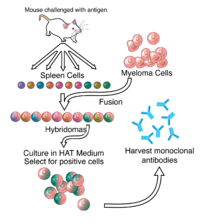
Photo from wikipedia
Objective: To investigate the clinical efficacy and safety of anti-IgE monoclonal antibody (omazumab) in the treatment of allergic united airway disease (UAD) in the real-wold. Methods: Retrospective cohort study summarizes… Click to show full abstract
Objective: To investigate the clinical efficacy and safety of anti-IgE monoclonal antibody (omazumab) in the treatment of allergic united airway disease (UAD) in the real-wold. Methods: Retrospective cohort study summarizes the case data of patients with allergic united airway disease who were treated with anti IgE monoclonal antibody (omalizumab) for more than 16 weeks from March 1, 2018 to June 30, 2022 in the Peking University First Hospital.The allergic UAD is defined as allergic asthma combined with allergic rhinitis (AA+AR) or allergic asthma combined with chronic sinusitis with nasal polyps (AA+CRSwNP) or allergic asthma combined with allergic rhinitis and nasal polyps (AA+AR+CRSwNP). The control of asthma was evaluated by asthma control test (ACT), lung function test and fractional exhaled nitric oxide (FeNO). The AR was assessed by total nasal symptom score (TNSS). The CRSwNP was evaluated by nasal visual analogue scale (n-VAS), sino-nasal outcome test-22 (SNOT-22), nasal polyps score (TPS) and Lund-Mackay sinus CT grading system. The global evaluation of omalizumab for the treatment of allergic UADwas performed by Global Evaluation of Treatment Effectiveness(GETE).The drug-related side effects were also recorded. Matched t test and Wilcoxon signed-rank test were used to compare the score changes of IgE monoclonal antibody (omazumab) before and after treatment, and multivariate logistic regression analysis was used to determine the influencing factors of IgE monoclonal antibody (omazumab) response. Results: A total of 117 patients with UAD were enrolled, ranging in age from 19 to 77 years; The median age of patients was 48.7 years; Among them, 60 were male, ranging from 19 to 77 years old, with a median age of 49.9 years; There were 57 females, ranging from 19 to 68 years old, with a median age of 47.2 years. There were 32 cases in AA+AR subgroup, 59 cases in AA+CRSwNP subgroup, and 26 cases in AA+AR+CRSwNP subgroup. The total serum IgE level was 190.5 (103.8,391.3) IU/ml. The treatment course of anti IgE monoclonal antibody was 24 (16, 32) weeks. Compared with pre-treatment, omalizumab increased ACT from 20.0 (19.5,22.0) to 24.0 (23.0,25.0) (Z=-8.537, P<0.001), increased pre-bronchodilator FEV1 from 90.2 (74.8,103.0)% predicted value to 95.4 (83.2,106.0)% predicted value (Z=-5.315,P<0.001), increased FEV1/FVC from 80.20 (66.83,88.38)% to 82.72 (71.26,92.25)% (Z=-4.483,P<0.001), decreased FeNO from(49.1±24.8) ppb to (32.8±24.4) ppb (t=5.235, P<0.001), decreased TNSS from (6.5±2.6)to (2.4±1.9) (t=14.171, P<0.001), decreased n-VAS from (6.8±1.2) to (3.4±2.0)(t=14.448, P<0.001), decreased SNOT-22 from (40.0±7.9) to (21.3±10.2)(t=15.360, P<0.001), decreased TPS from (4.1±0.8) to (2.4±1.0)(t=14.718, P<0.001) and decreased Lund-Mackay CT score from (6.0±1.3) to (3.1±1.6)(t=17.012, P<0.001). The global response rate to omalizumab was 67.5%(79/117). The response rate in AA+AR (90.6%,29/32) was significantly higher than that in AA+CRSwNP (61.0%,36/59) and AA+AR+CRSwNP (53.8%,14/26) subgroups (χ2=11.144,P=0.004). Only 4 patients (3.4%,4/117) had mild side effects. Conclusion: The real-world study showed favorable effectiveness and safety of anti-IgE monoclonal antibody for treatment of allergic UAD. To provide basis for preventing the progress and precise treatment of allergic UAD.
Journal Title: Zhonghua yu fang yi xue za zhi [Chinese journal of preventive medicine]
Year Published: 2023
Link to full text (if available)
Share on Social Media: Sign Up to like & get
recommendations!